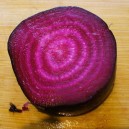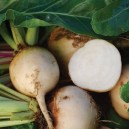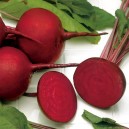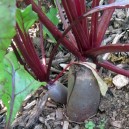
Welcome, Log in
Product Categories
-
Heirloom & OP Seed
- Cool Weather Crops
- Warm Weather Crops
- Beans
- Beetroot
- Brassicas
- Carrots
- Chard
- Corn/Maize
- Cucumbers
- Eggplant (Aubergine)
- Leeks
- Lettuce
- Melons
- Okra
- Onions
- Parsnips
- Peas
- Peppers & Chillies
- Radish
- Spinach
- Squash & Pumpkins
- Tomatoes
- Turnips
- Unusual / Exotic
- Herbs & Spices
- Fruits & Berries
- Value Packs
- View All Seed
- Gift Vouchers
BeetrootThere are 6 products.
Please scroll down or click here to view the product list
GROWING INSTRUCTIONS FOR BEETROOT
Binomial Name: Beta vulgaris
Varieties: Bull's Blood, Chiogga, Crimson Globe, Cylindra, Detroit Dark Red, Early Wonder, Albino, Golden (Burpee's Golden).
Start: Seeds or seedlings
Germination: 5 to 8 days, 5°C to 30°C
Seed Life (viability): 4 years
Soil: Tolerates low fertility
Sunlight: Full sun, part shade
Sow Seeds: 2.5 cm apart
Transplant Seedlings: 7 to 10 cm apart
Ave. Days to Harvest: 50 to 55
Good Companions: Lettuce, Kohlrabi, Onions, Brassicas, Catnip, Garlic, Basil, Mint, Sage
Bad Companions: Runner or Pole Beans
Sowing & Planting: Plant beetroot in early spring, as soon as you can work the soil, 2 cm deep and 2.5 cm apart in rows 30 to 45 cm apart. For continuous harvest, make successive plantings every three weeks until midsummer. For cold winter storage, sow a crop about 10 weeks before the first heavy freeze.
Beetroot prefers well-drained sandy loam to silt loam soil, high in organic matter, with pH between 6.5 and 7 and free of large stones. A good loose soil structure is important because growth is improved by good soil aeration.
The wrinkled, compound “seedball” usually contains two to four viable seeds, making it necessary to thin to 7 to 10 cm spacings if you plan to harvest young, small or cylindrical-shaped roots, or 15 cm spacings for larger roots.
Begin thinning when seedlings are about 10 to 12 cm tall, and eat the thinnings. Cut rather than pull plants when thinning to avoid disturbing roots of other plants. Unlike most root crops, beets can be started inside or in cold frames and transplanted into the garden.
Growing: Use floating row covers to discourage insects early in the season. Keep well-weeded. Competition and uneven watering can make beets stringy and tough. Beets tolerate average to low fertility. Too much nitrogen will encourage top growth at the expense of root development. Best color and flavor develop under cool conditions and bright sun. When beets mature in warm weather, they are lighter colored, have less sugar and have more pronounced color zoning in the roots. Fluctuating weather conditions produce white zone rings in roots.
Beets are closely related to Swiss chard and spinach so avoid following these crops in rotation. Beets are biennials grown as annuals for the roots and greens. Normally, they produce an enlarged root during their first season. Then after overwintering they produce a flower stalk. If they experience two to three weeks of temperatures below 7°C after they have formed several true leaves during their first season, a flower stalk may grow prematurely. Many newer varieties are less sensitive to this problem.
Harvesting: Beetroot can be harvested whenever they grow to the desired size. About 60 days are required for the beetroot to reach 4 cm in diameter, the size often used for cooking, pickling or canning as whole beets. They then enlarge rapidly to 7 to 8 cm with adequate moisture and space. With most varieties, beetroot larger than 7 to 8 cm may become tough and fibrous.
When harvesting beetroot, separate the green tops from the roots as soon as possible, leaving 2 to 3 cm of stem on the beetroot, otherwise the greens will quickly start drawing the moisture from the root greatly reducing flavor and the beetroot will become shriveled. Beetroot greens are packed with nutritional value but must be prepared separately.
After separating, beetroot store well for about a week in perforated plastic bags in the refrigerator. Do not allow them to freeze. Use beetroot while they are still firm and fresh.
-
R 25.00Add to cart More Details
Available -
R 25.00Add to cart More Details
Available -
R 25.00Add to cart More Details
Available -
R 25.00Add to cart More Details
Available -
R 25.00Add to cart More Details
Available -
R 25.00Add to cart More Details
Available











